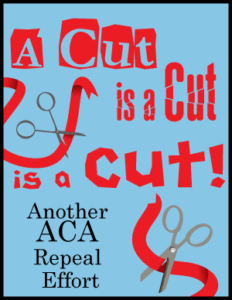 Do not be fooled by the new, and so-called, “Health Care Choices Proposal” from a set of conservative think tanks that claims to provide our health care system more choice and flexibility. As usual there is an ideology underpinning conservatives’ take on a sound health care system, so let us go behind the puffery and look at the details of this proposal.
Do not be fooled by the new, and so-called, “Health Care Choices Proposal” from a set of conservative think tanks that claims to provide our health care system more choice and flexibility. As usual there is an ideology underpinning conservatives’ take on a sound health care system, so let us go behind the puffery and look at the details of this proposal.
Pure and simple, the conservatives’ proposal provides a limited block grant to states for coverage now provided through the health insurance marketplaces. Essential health benefits, age rating, and minimum loss ratio requirements would not apply to these block grants. In order to comply with more limited federal funding, states would need to create less generous coverage options. And the states that have not expanded Medicaid will not be able to do so because the limited block grant funding is based on a state’s past spending.
Why is open-ended funding so important (or the reverse – why is a block grant so bad) for health care coverage? Under the Affordable Care Act, anyone who buys coverage on a marketplace is eligible for tax credits. The federal funding is not limited overall or per person. A block grant shifts the responsibility onto the states. If more people become eligible (either because of a recession or natural disaster or other unplanned event), the state will not get more federal funding. Let’s just think about Texas, Florida and Puerto Rico in the past year – none of them planned to get hit by massive hurricanes but because they did, they had a lot more people needing government subsidized health care as they recovered. Under the conservatives’ proposal, however, grants would not expand if more people than expected become eligible. So states with increased enrollment would have less to spend per person. Which means less health care, and the only choice would be choosing which services would be taken away or which people would not be eligible.
The proposal also talks about refocusing subsidies on those who need them most. Under the ACA, individuals between 100 – 400 percent of the FPL (Federal Poverty Level) get subsidies to help pay their premiums, as well as lawfully present immigrants under 100 percent FPL who are ineligible for Medicaid due to their immigration status. And before President Trump took them away, anyone 100 – 250 percent FPL could get cost sharing reductions. Low income individuals are already getting help. Where would the funding be refocused? Currently, individuals above 400 percent of the federal poverty level do not get subsidies and often cannot afford insurance. But if states wanted to give subsidies to higher income individuals, they would not get more money so, once again, there is less money to go around. Back to the state to make more choices about limiting services or imposing higher out-of-pocket costs. When you limit the money to the states, states have no options but to cut eligibility or services or raise out-of-pocket costs or premiums.
The proposal includes other flowery language — ensuring all people can choose a private health plan, giving low-income individuals more choice, protecting life (this last piece is code for preventing states from covering abortion).
But eventually you do find the only truthful nugget in the conservatives’ entire proposal – “Put federal spending on a real budget.” This proposal is not about providing the highest quality health care at the lowest cost, which our nation should do from a financial, moral and human rights perspective. Instead, this proposal dresses up terms like flexibility and state choice as a guises for cutting federal funding. It is true that we would all love to find ways to spend less money on health care. But just cutting federal funding without changing the system will not do it. Less money equals less care, there is no way around it.
So let us call this proposal what it is – another barely veiled attempt to repeal the ACA. I certainly do not want to go back to the days when people with pre-existing conditions could not get coverage, when even basic essential benefits were not covered by many plans, and when maternity care and mental health services were excluded in most private health insurance coverage. Do not be swayed by the conservative groups’ policy and words, follow their actions and follow the money – a block grant is a cut and a cut is not the prescription to cure the ills of the health care system now or ever.
